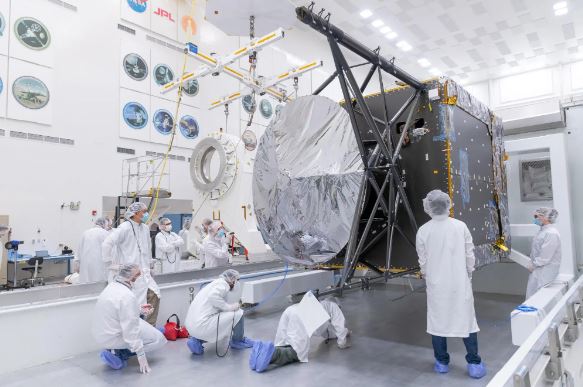Is Psyche actually a metallic piece of an asteroid? Is the almost Massachusetts-sized object the remnant of a young planet whose rocky crust was ripped off in a catastrophic early Solar System collision?
On Friday at 10:19 a.m. Eastern time, that expedition set sail. The huge spaceship was launched from Kennedy Space Centre in Florida by SpaceX’s most powerful rocket, the Falcon Heavy.
Despite early, unfavourable weather forecasts, Friday’s flight appeared to go off without a hitch. About an hour after liftoff, the Psyche spacecraft separated from the Falcon Heavy’s upper stage. NASA’s live feed showed the ship disappearing into the night sky as it left on its six-year, multibillion-mile journey.
About five minutes later, when the first signal from the spacecraft arrived, the mission’s management celebrated in the control room at NASA’s Jet Propulsion Laboratory in California.
For a very long time, Psyche, the asteroid, has been a mystery. It was just the sixteenth asteroid ever found when Annibale de Gasparis, an Italian astronomer, saw it in 1852. Early observations showed it to be little more than a point of light orbiting the sun like any other asteroid.
Professor of earth and space exploration at Arizona State University Jim Bell, who will lead studies of the asteroid with the spacecraft’s camera instrument, has said that astronomers have known since the 1960s that Psyche’s colour is similar to iron meteorites that have fallen to Earth based on observations made with telescopes. Psyche’s radar reflections were brighter than those from other tiny objects in the asteroid belt when astronomers bounced radar pulses off of them.
And then scientists saw that Psyche’s orbit was diverted in a way that suggested something pretty enormous, and maybe much denser than rock, was in the vicinity of Psyche as it passed quite near to larger planets.
Density is measured in grammes per cubic centimetre, and most rocks like granite fall between two and three grammes. A cubic centimetre of water (liquid or frozen) weighs around one gramme. Iron and other metals have densities of six to nine grammes per cubic centimetre, making them significantly heavier.
It seemed like Psyche was made nearly entirely of metal. Based on its dimensions, Psyche has been interpreted as the possible remains of a core comparable to Earth’s, which is composed of iron and nickel. The denser metals on these worlds melt at high enough temperatures to sink to the centre, earning them the name “planetesimals.”
While it would be difficult to travel the 1,800 miles to Earth’s core and back, a trip to Psyche may provide light on the subject.
Asteroid density was once estimated to be higher than four grammes per cubic centimetre; however, more recent observations have resulted in lower estimations of the asteroid’s density. That means Psyche is not entirely metallic; it might be formed of rock or nothing at all.
Psyche is too far away to be mined with present-day technology if it turns out to be rich in precious metals. According to Dr. Elkins-Tanton, even at its closest approach, Psyche is still around five times farther from Earth than Earth is from Mars.
The Psyche mission’s takeoff was supposed to have occurred a year ago. The spacecraft was delivered to the Kennedy Space Centre ahead of schedule. However, there were issues with the spacecraft’s navigation software during testing. These were caused by discrepancies between the flight programme and the verification software. The launch window closed before the problems could be resolved by the engineers.
Getting to the launchpad wasn’t the only obstacle. Due to unexpectedly high temperatures generated by the thrusters needed to orient the spacecraft during flight, the launch of Psyche had to be pushed back from its original October 5 date. The problem, according to NASA officials, has been fixed, and the thrusters will now be operated at reduced power to minimise overheating in space.
Multispectral imagers, the type of camera used on this mission, will provide the first detailed view of Psyche’s surface. The asteroid’s topography may bear the imprint of a long-lost magnetic field, and the spacecraft’s magnetometer will look for such evidence.
High-energy gamma rays and neutrons created when cosmic rays collide with the asteroid’s surface can be detected with a gamma-ray spectrometer. Metal and rock data from Psyche’s unearthly terrain may be deduced from the distribution and composition of these particles.
Psyche has been a faint star in the night sky for almost 170 years. Its distinctive proportions and characteristics have been partially exposed by telescopes, yet much about this planet remains unknown. The Psyche spacecraft is currently in route to finally reveal this asteroid in all its glory and discover its mysterious origin.

